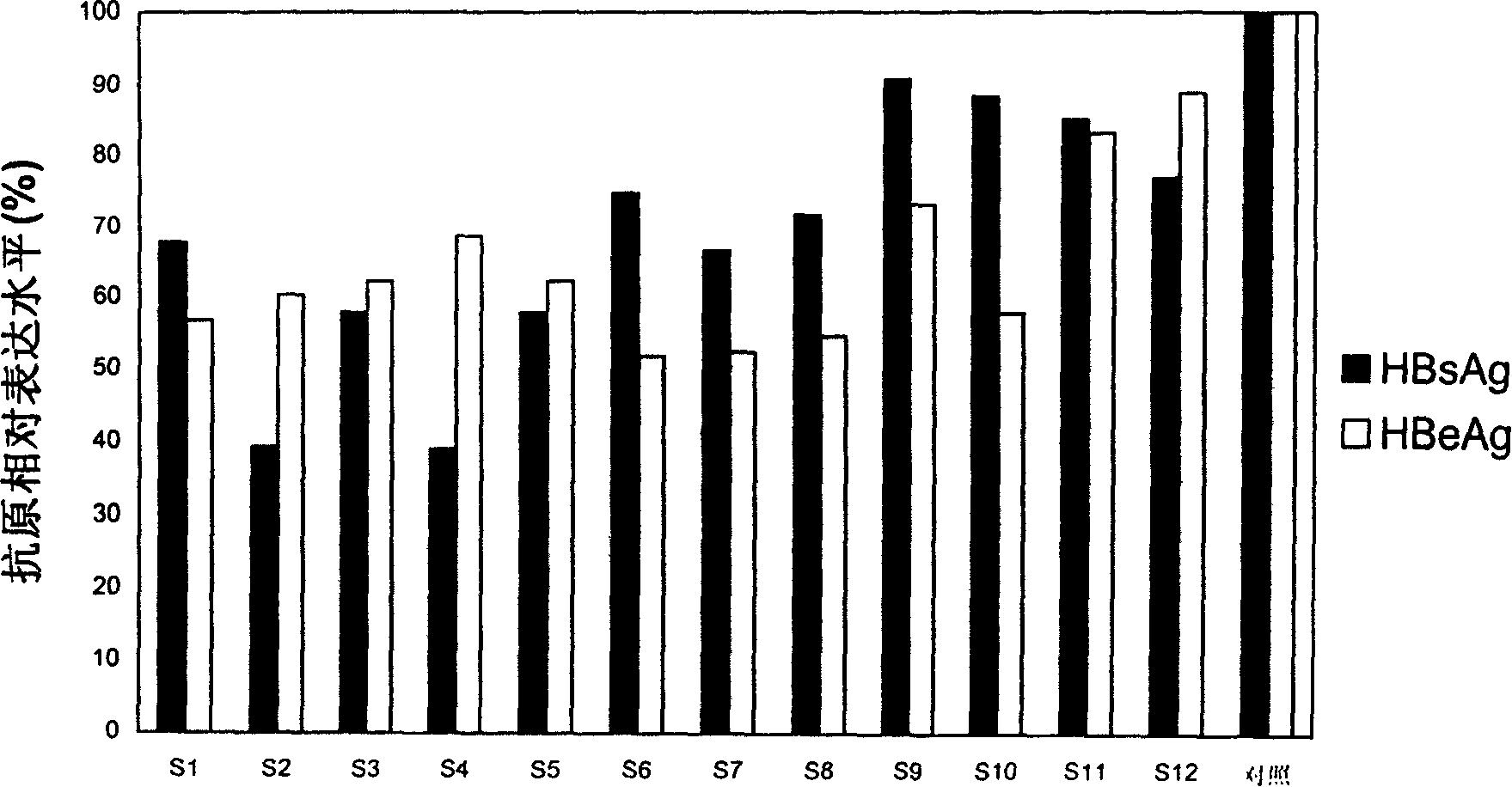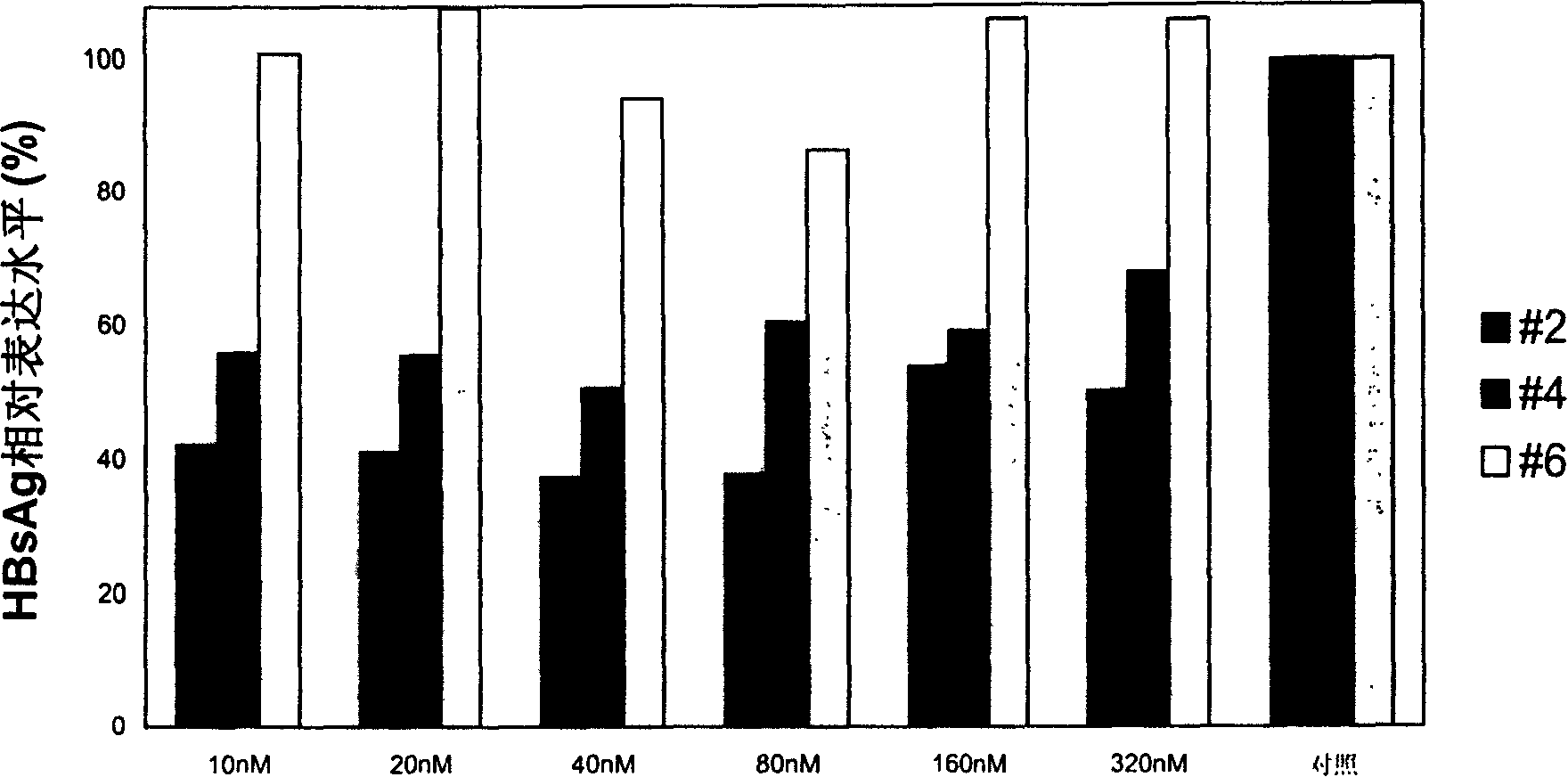Small interference RNA molecule SiRNA capable of attacking human hepatitis B virus and application thereof
A technology of hepatitis B virus and small interference, which is applied in the field of nucleic acid, and can solve the problems of low conversion rate of hepatitis B virus surface antigen, poor specificity of hepatitis B virus, low efficiency of hepatitis B virus, etc.
- Summary
- Abstract
- Description
- Claims
- Application Information
AI Technical Summary
Problems solved by technology
Method used
Image
Examples
Embodiment 1
[0103] Example 1 Synthesis of siRNA
[0104] The synthesis of siRNA can be entrusted to commercial companies that openly carry out synthesis business, such as Dharmacon in the United States, specifically through www.dharmacon.comIt was known that all siRNA molecules were deprotected at the 2-position, desalted, purified, and annealed to form double strands, and then dissolved in DEPC-treated distilled water. The synthetic methods used are general methods, such as the methods disclosed in the following documents: Scaringe SA, Wincott FE, and Caruthers MH. Novel RNA Synthesis Method Using 5′-Silyl-2′-Orthoester Protecting Groups.J Am Chem Soc 1998 ;120:11820-11821.
[0105] The preparation method of the small interfering RNA molecule (SiRNA) provided by the present invention can also adopt the existing solid-phase chemical synthesis method. This method is available in: Wincott f, DiRenzo A, Shaffer C, Grimm S, Tracz D, Workman C, Sweedler D, Gonzalez C, Scaringe S and Usman N...
Embodiment 2
[0115] Example 2 Transfection of SiRNA
[0116] 1. The cell model of hepatitis B virus: the cell model of hepatitis B virus is HepG2.2.15 cell line. This cell line was formed in 1987 when Dr. Acs' laboratory transformed the full length of AYW subtype hepatitis B virus into HepG2. It has been the standard cell used to screen anti-hepatitis virus drugs in vitro. The cells were cultured in vitro with RPMI1640 medium containing 10% fetal bovine serum and regularly screened with G418 to maintain high expression of hepatitis virus. (Sells MA, Chen ML, Acs G. Production of hepatitis B particles in HepG2 cells transfected with cloned hepatitis B virus DNA. PNAS1987; 84: 1005-1009.)
[0117] 2. SiRNA transfection: SiRNA was transferred into HepG2.2.15 cells by means of Oligofectamine from Invitrogen (www.invitrogen.com), and the specific steps were carried out according to the instructions. The brief description is as follows, 5×10 4 The HepG2.2.15 cells were seeded on 24-well cultu...
Embodiment 3
[0120] Example 3 Inhibitory effect of siRNA on virus replication and pathogenicity-related protein synthesis in hepatitis B virus cell model
[0121] 1. Selection of the hepatitis B virus cell model: In this example, the hepatitis B virus cell model was used as the standard HepG.2.2.15 cell line, which was formed by screening after liver cancer cells were transfected with the whole genome of the AYW subtype of hepatitis B virus. Hepatitis virus can stably replicate and multiply in this cell line, and can produce various antigenic proteins of the virus.
[0122] 2. Selection of SiRNA: As mentioned above, the hepatitis B virus genome expresses five kinds of mRNA molecules, each mRNA molecule is responsible for encoding different proteins, and the positions of transcription initiation and termination on the genomic DNA molecule are also different. Therefore, the positions of the coding regions of different proteins corresponding to the genomic DNA are different, among which the c...
PUM
 Login to View More
Login to View More Abstract
Description
Claims
Application Information
 Login to View More
Login to View More - R&D
- Intellectual Property
- Life Sciences
- Materials
- Tech Scout
- Unparalleled Data Quality
- Higher Quality Content
- 60% Fewer Hallucinations
Browse by: Latest US Patents, China's latest patents, Technical Efficacy Thesaurus, Application Domain, Technology Topic, Popular Technical Reports.
© 2025 PatSnap. All rights reserved.Legal|Privacy policy|Modern Slavery Act Transparency Statement|Sitemap|About US| Contact US: help@patsnap.com



